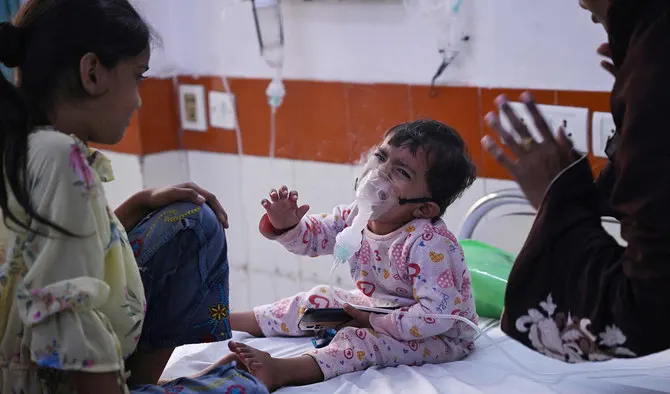Crying in a hospital bed with a nebuliser mask on his tiny face, one-month-old Ayansh Tiwari has a thick, hacking cough. His doctors blame the acrid air that blights New Delhi every year.
The spartan emergency room of the govern-ment-run Chacha Nehru Bal Chikitsalaya hospital in the Indian capital is crowded with children struggling to breathe — many with asthma and pneumonia, which spike as air pollution peaks each winter in the megacity of 30 million people.
Delhi regularly ranks among the most polluted major cities on the planet, with a melange of factory and vehicle emissions exacerbated by seasonal agricultural fires.
“Wherever you see there is poisonous smog,” said Ayansh’s mother Julie Tiwari, 26, as she rocked the baby on her lap, attempting to calm him.
“I try to keep the doors and windows closed as much as possible. But it’s like breathing poison all the time. I feel so helpless,” she told AFP, fighting back tears.
On Thursday, the level of PM2.5 particles — the smallest and most harmful, which can enter the bloodstream — topped 390 micrograms per cubic metre, according to monitoring firm IQAir, more than 25 times the daily maximum recommended by the World Health Organization.
Government efforts have so far failed to solve the country’s air quality problem, and a study in the Lancet medical journal attributed 1.67 million premature deaths to air pollution in the world’s most populous country in 2019.
“It’s a maddening rush in our emergency room during this time,” said Dhulika Dhingra, a paediatric pulmonologist at the hospital, which serves poor neighbourhoods in one of Delhi’s most polluted areas.
The foul air severely impacts children, with devastating effects on their health and development.
Scientific evidence shows children who breathe polluted air are at higher risk of developing acute respiratory infections, a UNICEF report said last year.
A study published in the Lung India journal in 2021 found nearly one out of every three school-children in Delhi had asthma and airflow obstruc-tion.
Children are more vulnerable to air pollution than adults because they breathe more quickly and their brains, lungs and other organs are not fully developed.
“They can’t sit in one place, they keep running and with that, the respiratory rate increases even more. That is why they are more prone to the effects of pollution,” said Dhingra.
“This season is very difficult for them because they can hardly breathe.” Vegetable vendor Imtiaz Qureshi’s 11-month-old son Mohammad Arsalan was admitted to the hospital overnight with breath-ing issues.
“We have to live day in and day out in this air,” said the distraught 40-year-old, who pulls his cart through the streets every day.
“If I go out, the air will kill me. If I don’t, pov-erty will kill me.”
The hospital provides treatment and medicine free of cost — none of its patients can afford private healthcare, and many cannot buy even a single air purifier for their one-room homes in the city’s sprawling slums.
Paediatrician Seema Kapoor, the hospital’s di-rector, said patient inflows had risen steadily since the weather cooled, trapping pollutants closer to the ground.
“About 30-40 percent of the total attendance is primarily because of respiratory illnesses,” she said.
Pulmonologist Dhingra said the only advice they can offer parents is to restrict their children’s outdoor activities as much as possible.
“Imagine telling a parent not to let the child go out and play in this toxic environment.”
The Delhi government has announced emer-gency school closures, stopped construction and banned diesel vehicles from entering the city in a bid to bring down pollution levels.
But stubble burning by farmers in the neighbouring agrarian states, which contributes significantly to Delhi’s pollution, continues un-abated, drawing a rebuke from the Supreme Court on Tuesday.—AFP










